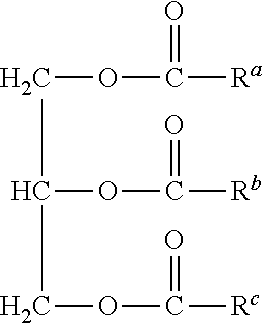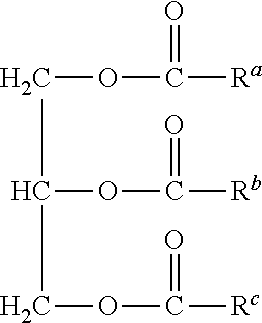Metathesis Catalyst and Process for Use Thereof
- Summary
- Abstract
- Description
- Claims
- Application Information
AI Technical Summary
Problems solved by technology
Method used
Image
Examples
synthesis example 1
[0104]Synthesis of (E)-2,6-diethyl-N-(2-methylpropylidene)aniline (compound 1). Benzene (150 mL) was added to 2,6-diethylaniline (18.59 g, 124.6 mmol) and 3 angstrom molecular sieves (ca. 50 mL). Then isobutyraldehyde (9.43 g, 131 mmol) and p-toluenesulfonic acid monohydrate (20 mg, 0.011 mmol) were added. The flask was sealed and heated to 50° C. After stirring overnight the very pale yellow solution was filtered and the volatiles were removed under reduced pressure to afford the product as a clear, pale yellow oil. Yield: 22.5 g, 84.6%. 1H NMR (C6D6): δ 7.21 (1H, d), 7.02 (2H, m), 2.47 (4H, q), 2.39 (1H, m), 1.11 (6H, t), 1.01 (6H, d).
[0105]Synthesis of lithium (2,6-diethylphenyl)(2-methylprop-1-enyl)amide (compound 2). Benzene (70 mL) and compound 1 (6.63 g, 32.6 mmol) were combined. Then solid lithium diisopropylamide (4.01 g, 37.4 mmol) was added. The mixture was heated to 50° C. to form a cloudy red-orange solution. After a few hours the solution was filtered through diatomace...
example 1
[0108]A stock solution was made by dissolving 4.5 mg of 2-(2,6-diethylphenyl)-3,3,5,5-tetramethylpyrrolidine[2-(i-propoxy)-5-(N,N-dimethylaminosulfonyl)phenyl]methylene ruthenium dichloride in 25 mL anhydrous dichloromethane. 1.0 mL (0.87 g) methyl oleate, 1.26 g (125 nmol catalyst) of catalyst stock solution, 3.7 g anhydrous dichloromethane, and 0.152 g (0.2 mL) tetradecane as an internal standard were weighed out and then placed in a Fisher-Porter bottle equipped with a stir bar. The vessel was then filled with ethylene to 150 psig (1034 kPa) and placed in an oil bath heated to 40° C. for 2 hours. After completion the vessel was depressurized and approximately 0.5 mL ethyl vinyl ether was added to stop the reaction. A sample was then taken and analyzed by GC as described above.
example 2
[0109]This example was run according to the procedure in Example 1, except that the amount of catalyst for this run was halved such that 0.63 g (62.5 nmol catalyst) of catalyst stock solution was added along with 4.4 g anhydrous dichloromethane. The amount of methyl oleate (1.0 mL, 0.876 g) and tetradecane standard (0.2 mL, 0.152 g) remained the same. The reactants were placed in a Fisher-Porter bottle and into a 40° C. oil bath for 2 hours, after which ethyl vinyl ether was added to stop the reaction. A sample was taken and analyzed by GC as described above.
PUM
| Property | Measurement | Unit |
|---|---|---|
| Fraction | aaaaa | aaaaa |
| Fraction | aaaaa | aaaaa |
| Mass | aaaaa | aaaaa |
Abstract
Description
Claims
Application Information
 Login to View More
Login to View More - R&D
- Intellectual Property
- Life Sciences
- Materials
- Tech Scout
- Unparalleled Data Quality
- Higher Quality Content
- 60% Fewer Hallucinations
Browse by: Latest US Patents, China's latest patents, Technical Efficacy Thesaurus, Application Domain, Technology Topic, Popular Technical Reports.
© 2025 PatSnap. All rights reserved.Legal|Privacy policy|Modern Slavery Act Transparency Statement|Sitemap|About US| Contact US: help@patsnap.com



